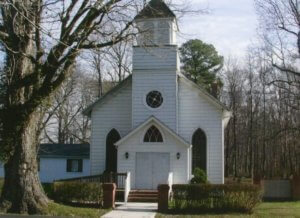Unionville, Maryland is an African-American community settled in 1867 by ex-slaves and free blacks who had fought in the Union Army (1863-1867) during the Civil War. Located 4.5 miles northwest of Easton on Maryland Route 370, the community of Unionville grew after the war to nearly 40 buildings.
The formation of Unionville is credited to Ezekiel and Sarah Cowgill and their sons James and John – all were Quakers and known to be ardent abolitionists. The Cowgills, who owned the nearby Lombardy Plantation, carved out a parcel of land for the Civil War veterans who were local soldiers in the United States Colored Infantry Regiment. When the soldiers returned home, the Cowgills offered each of the eighteen veterans a plot of land at the rate of one dollar a year for thirty years. Their leases stipulated that the plot of land was offered to free African-Americans provided they would also build a church and school house in their community. This they did. The Unionville Church, now named St. Stephens A.M.E. Church, still exists and in its cemetery are buried the 18 black soldiers who fought for the Union in the Civil War. Starting in 1867, the first leases that were recorded referred to the leased land as being at “Lombardy” or as “Cowgilltown. From 1870 onward the leases state “The Village of Unionville.” Thus, the community is known today as “Unionville,” in honor of the Union Army that the African-Americans credit with winning their freedom. Unionville continues to thrive today with pride in its historic heritage.

St. Stephens A. M. E. Church today in the community of Unionville on Maryland Route 370.
Further Reading
Online Articles
- After the Civil War, African-American Veterans Created a Home of Their Own: Unionville
- 2017 Smithsonian Magazine article by Natalie Hopkinson
- Unionville’s founders celebrated as town marks 150 years
- 2018 WBAL article by Jason Newton
- Unionville, Maryland
- 2013 Travel Hag article by Mindie Burgoyne
Videos
- Unionville
- In this 2017 video created by Talbot Rising, “Rev. Nancy Dennis, pastor of the St. Stephens AME Church in Unionville; Harriette Lowery, an Easton native and a descendant of one of the founders of Unionville, and Prof. Dale Green, an architectural historian at Morgan State University and also an Easton native, talk with Ridgely Ochs about Unionville’s founding and its place in the rich and deep story of African-Americans on the Eastern Shore.”
Sources
This summary was written by THS board member Dr. Willie Woods for our African American Room exhibit.
The photo on the main page is Teacher Martha Ray Chase Greene and her students at the Unionville School House. Among the students are Freddy DeShields and Theresa DeShields. c.1948 Harriette Lowery Collection
